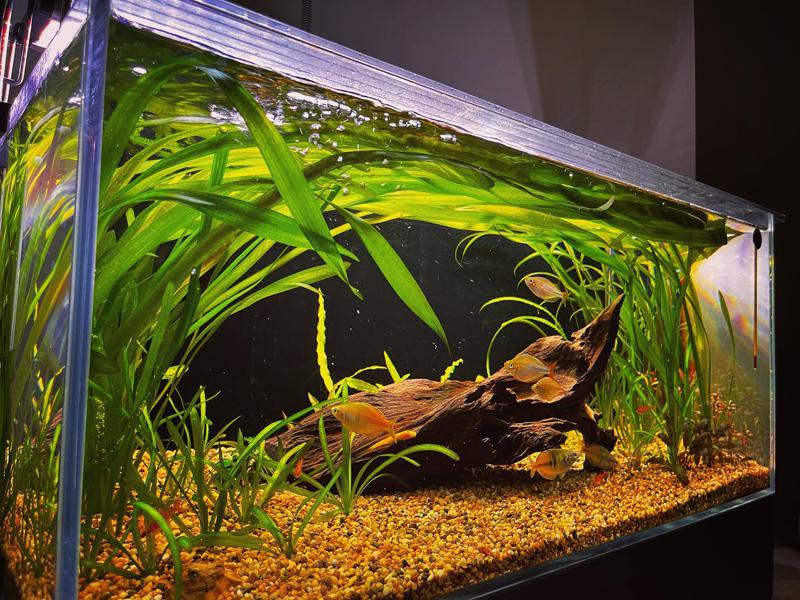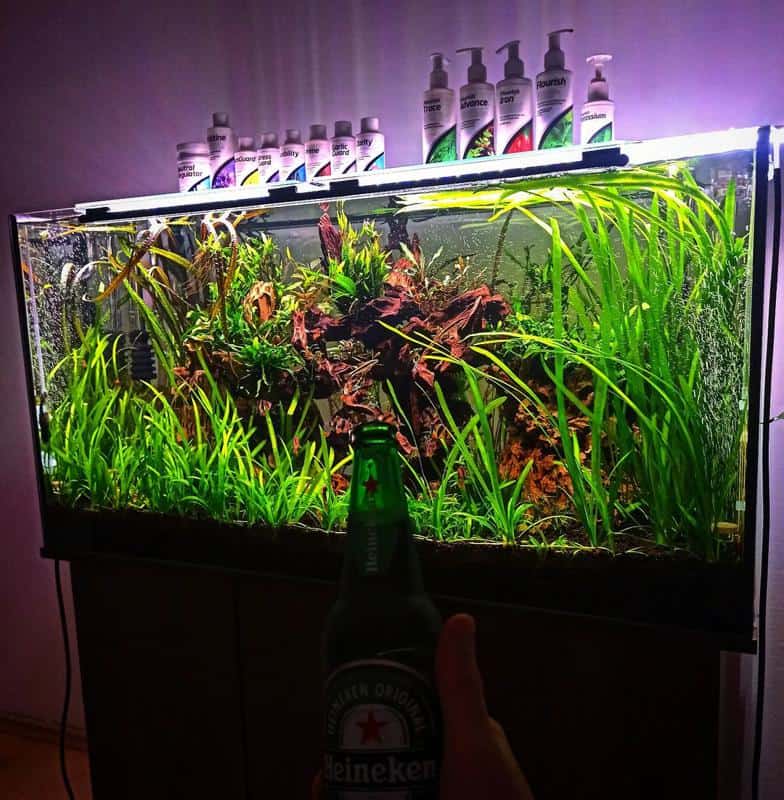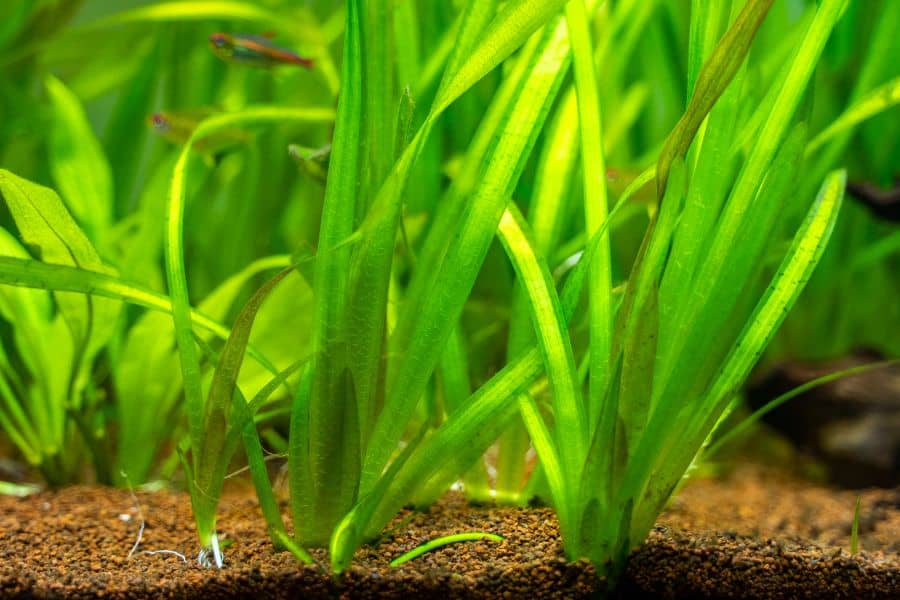Well known for its ease of care, vallisneria plants are one of the most popular beginner friendly plants for a starting aquarist. In this article, we’ll be going over the plant in detail, such as its structure, how to properly plant and care for them, and troubleshooting any problems along the way.
Vallisneria, regardless of variety, has an overall grass-like appearance and can be distinguished by its rounded leaf tips.
Vallisneria needs to be planted under a substrate, after which it’ll require little maintenance to grow (though adding supplements to the water and increasing light intensity can hasten the plant’s growth).
Before continuing onto the planting and caring process, let’s first have a look at what makes vallisneria plants unique and why they can benefit your tank in more ways than one.
What Is Vallisneria?
In order to get a better understanding of vallisneria plants, here is a general guide about the plant, including its structure, variants, and uses for your tank.
Where Do Vallisneria Plants Originate?
Vallisneria is a plant genus in the family Hydrocharitaceae, which itself is in the order Alismatales. This family includes monocotyledonous flowering plants and a variety of aquatic plants native to both freshwater and marine environments.
Vallisneria plants grow naturally across much of the United States, as well as in parts of Canada and Central America. Different varieties may also be found in the tropical and subtropical parts of southern Europe and northern Africa, along with various regions in eastern and southeastern Asia.
What Does Vallisneria Look Like?
Vallisneria plants resemble tall grass in general, though their individual heights and leaf shapes will depend on the particular variety that you’ve chosen.
Despite this, one trait that all vallisneria plants share and is what makes them unique to other aquatic plants is the presence of rounded leaf tips.
The leaves themselves are covered with raised veins and appear usually green, though they can appear red or brown in certain cases depending on their care and variety.
Vallisneria are typically quite tall and can grow up to the water’s surface. It won’t grow beyond the surface however, but merely flow along on top of the water.
How Does Your Aquarium Benefit from Having Vallisneria?

Vallisneria can be beneficial to your aquarium in several ways, which are described here in detail:
- Vallisneria can provide a sense of safety for fry and shy fish, allowing them to feel more at ease and comfortable around their environment
- Vallisneria absorb nitrates and CO2 from the water and releases O2 into the water, making them easy to care for and allowing them to naturally filtrate the water
- By absorbing excess nutrients in the water, vallisneria plants devoid algae of their food source, making them less likely to form in the tank
- Vallisneria are very beginner friendly due to the fact that they can tolerate a wide range of water temperatures and pH levels, and have low lighting requirements
- Vallisneria grow and propagate quite quickly and easily, meaning that you can easily turn your aquarium into an aquascape with just one Vallisneria plant given time and care
Different Varieties of Vallisneria
Vallisneria is a common name that describes a genus of plants, meaning there are multiple species/varieties that share this name. Here are some of the most common ones you may encounter:
Valisneria Tortifolia
V. tortifolia is a small variety of vallisneria, with it reaching a maximum of about 8-9 inches in height. Its leaves are thin, green, and uniquely coiled, making this plant easy to identify.
Vallisneria Asiatica
This plant can grow to over 2 and a half feet with spiraling, light green leaves, which can turn a reddish hue occasionally. Its spiraling leaves resemble a corkscrew, which is sometimes used as the plant’s nickname.
Vallisneria Americana
A particularly common variant, the V. americana plant can grow to over 6 feet tall. It can survive brackish water and has red or green leaves with vertical stripes, giving them a wrinkly appearance.
Vallisneria Spiralis
Another common aquarium plant, the V. spiralis plant has thin, straight green leaves that can reach a maximum height of roughly 30 inches. As its name suggests, this plant has spiraling stems from which its flowers grow.
How to Plant Vallisneria

Setting Things Up
Before planting your vallisneria plant, here are some things to consider when setting up your tank:
Tank Size
Because vallisneria plants can grow relatively large in a short period of time, you should have at least a 10-gallon tank for small varieties of the plant, though you’ll need to constantly prune and remove runners to prevent it growing too large. Larger varieties can easily require up to a 100-gallon tank since many can grow up to 6 feet tall.
Temperature and pH
Vallisneria plants can tolerate temperatures between 60 and 84 degrees Fahrenheit, though they grow best within the 64 to 82 degrees Fahrenheit range. Though they may be able to handle temperatures beyond these ranges, they most likely won’t grow.
Vallisneria can survive a pH ranging from 6.0 to 9.0, though they’ll grow best within the 6.5 to 8.5 range.
Substrate
Vallisneria will require substrate to grow, preferably something fine-grained, such as sand or gravel. With sand, you should add root tabs in order to provide the necessary nutrients for the plant.
Lighting
Moderate lighting would fit vallisneria plants well, though they can tolerate low light as well. High lighting will allow the plant to grow and produce runners rapidly (something to potentially be aware of), and may give it a red hue.
Filtration
Though they remove excess nutrients from the water, it’s still best to keep the water well-filtered. Currents are not an issue for the plant as long as its well anchored.
What to Do
Here is a list of steps to follow in order to properly plant your vallisneria plant:
- The roots of the plant should be placed under the substrate
- You may add root tabs below the roots to maximize nutrient availability and absorption (optional)
- The crown of the plant (light-colored area at the base of the plant above the roots) should be left above the substrate. The crown produces the leaves, so leaving it buried can potentially cause the plant to die
- Choose a location toward the back of the tank for the vallisneria, since they can often become very tall (dwarf varieties are an exception)
Caring for Vallisneria

Besides their aesthetic factor, vallisneria are also known for being very easy to care for.
You don’t have to worry about them growing above the water surface if they get too tall, rather they’ll stay at the surface and flow with the current (though this can get messy if the leaves become too long). A good idea is to prune the plant once in a while to prevent it overtaking the tank.
Pruning Vallisneria
Its best to trim the leaves using a pair of scissors to your preferred height. Before doing so, make sure the plant has been given a few weeks to root into the substrate and settle in the aquarium.
Propagating Vallisneria
Vallisneria are able to propagate on its own via runners.
Once the plant has settled in the aquarium, it’ll begin to grow runners beneath the substrate and spread across the tank. The new plants that grow from these runners will eventually develop runners of their own, easily overwhelming your tank.
In order to prevent this from happening, you can either pull out the runners using aquarium tongs, or clip them off the main plant. You can then choose to either plant these runners somewhere else in the aquarium, or simply dispose of it.
Things to Watch Out For
Two of the main issues you should be aware of are fish uprooting the plant, or if the plant begins to overtake the aquarium.
Fish May Uproot the Plant
Although vallisneria are overall not very appetizing to fish, the fish can nonetheless harm the plant by uprooting it. Goldfish and cichlids are particularly known for this.
Because vallisneria take time to root into the substrate, they become particularly vulnerable to uprooting during their first few weeks in the aquarium.
You can try to use plant weights, in-tank pots, or other barriers to prevent the fish reaching the plant, but they may be able to find a workaround. You may also consider planting the plant first and giving it enough time to settle before introducing certain fish to the tank.
Plant Is Overtaking the Aquarium
As mentioned earlier, a potential problem with growing vallisneria is the risk of them overtaking the aquarium when they propagate out of control. I
n order to avoid this issue, be aware of new runners and remove them from any area (using the methods previously discussed) you no longer wish the plant to grow in.
Also Read:
FAQs
1. What Consumes Vallisneria?
Several types of marine inhabitants are known to consume vallisneria, though the exact type depends on the variant of the plant. Some notable examples include:
- 1. Diving ducks (i.e. canvasback)
- 2. Waterfowl
- 3. Turtles
- 4. Snails
- 5. Goldfish (particularly fond of the spiralis variant)
Conclusion
Vallisneria plants are some of the most commonly found plants in aquariums due to their ease of care and appealing appearance.
With a bit of research and preparation, you should have no trouble turning your aquarium into a lush green paradise for all its inhabitants.
